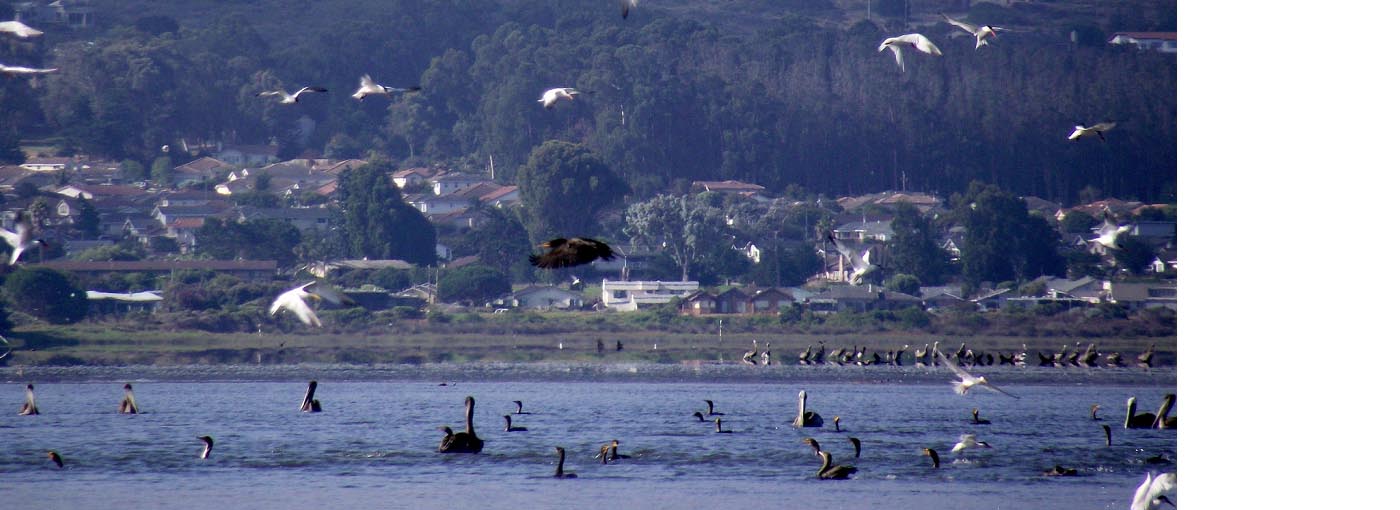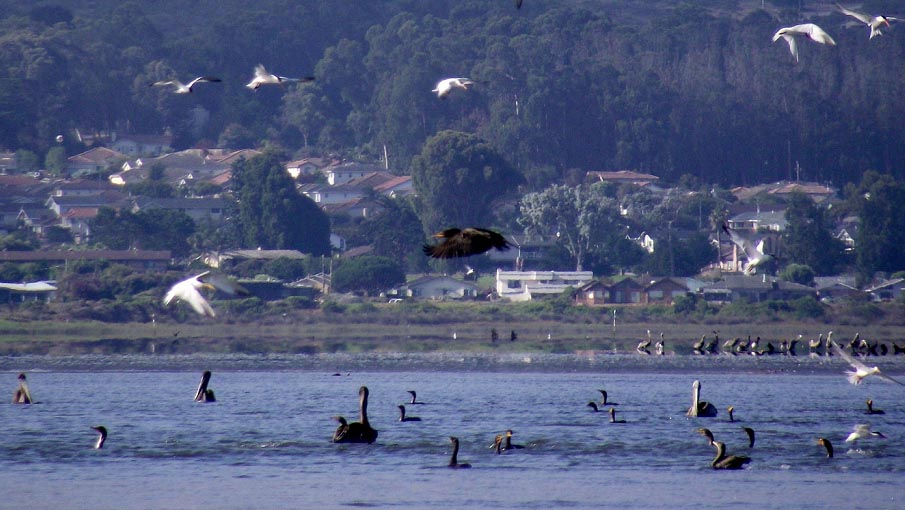Birding the Morro Bay Estuary

Photo: Feeding Frenzy Morro Bay by Steve Schubert
Format this fall:
- In person van field trip (limited to 12 enrollments): Sat., Nov 2nd from 9:00am-3pm. Class will start at the Cuesta College San Luis Obispo Campus before commencing on van trip. Participants are encouraged to bring binoculars, spotting scopes (if available), and references i.e.., birding field guides and/or birding apps such as "Merlin". Bring water, snacks, and a sack lunch. Dress in layers for variable weather conditions. Parking permits are required to leave your car on campus.
Identify many of the migratory, over-wintering, nesting, and year-long resident bird species that occupy the many diverse habitats here on the Central Coast. Practice bird watching skills that rely on observing characteristic field marks, bird behavior, and the acquired skill of ‘birding by ear’.
Participants will observe and identify passerine (perching) birds, shorebirds such as sandpipers and plovers, waterbirds such as ducks, geese, loons, grebes, gulls, pelicans and cormorants, long-legged waders such as herons and egrets, and birds of prey, including the famous locally nesting peregrine falcons at Morro Rock and sightings of fish-hunting osprey over the bay. The annual Morro Bay Christmas Bird Count ranks among the highest counts in North America for the numbers of bird species found within a 15-mile diameter count circle, and the annual Big Sit birding survey overlooking Morro Bay from the Elfin Forest is also nationally renowned.
Take an in-person field trip to Morro Bay estuary and its 48,000-acre watershed. Morro Bay's coastal salt marsh, mudflats, estuary, beach, dunes, and associated upland watershed are recognized as vital feeding and resting habitats for thousands of birds migrating along the Pacific Flyway, arriving and departing from as far away as the arctic tundra to the north and the Neotropical rainforests to the south. Make stops at several of the publicly accessible and popular birding locations along the perimeter of the bay, including Morro Rock, the Heron Rookery, State Park Marina, the Elfin Forest boardwalk and Audubon Overlook in Baywood Park, and the Sweet Springs Nature Preserve in Los Osos.
Register Online - FULL
DATE: 1 Saturday: November 2, 2024
TIME: 9:00am - 3:00pm
FEE: $65
LOCATION: San Luis Obispo campus Room 2604 4117
MODE OF DELIVERY: Meet for in person lecture before van field trip
INSTRUCTOR: Steve Schubert
QUESTIONS: Contact instructor at s_schub1@msn.com
| Meet the instructor | |
|---|---|
 |
Steve attended college at Cal Poly, San Luis Obispo and received a Master’s degree in Field Biology and a Life Sciences Secondary Teaching Credential. He taught high school biology and earth sciences for several years, has taught natural history courses for Cuesta College Community Programs more than 25 years and works as a naturalist instructor at a local residential outdoor school program called Camp KEEP (Kern Environmental Education Program), attended by more than 3,000 6th grade students each school year. He served on the committee that published the book “Wildflowers of San Luis Obispo” and the eBook “Plants of the Carrizo Plain”. Steve authored the book entitled “The Peregrine Falcons of Morro Rock – A 50-year History”, available at Amazon.com. He is past-President of Morro Coast Audubon Society and is the Volunteer Coordinator of the Hi Mountain Lookout Project (www.facebook.com/condorlookout), a restored fire lookout in Los Padres National Forest where volunteers and college interns radiotrack the movements of California Condors and conduct biological field research projects. He has been a speaker and field trip leader for the Morro Bay Winter Bird Festival each year since its inception more than 20 years ago. Steve enjoys kayaking, running, biking, hiking, playing basketball, and wildlife and landscape photography (photos at: http://www.flickr.com/photos/12571965@N07 |
